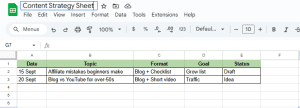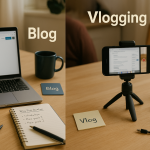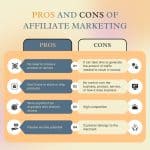A Straightforward Guide to Growing Your Business
Let’s be honest — “content marketing” sounds like one of those shiny buzzwords marketers love to throw around to sound clever. Like something you might buy in a jar at Boots. But it’s not. If you want people to notice your business online in 2025, you need a simple content marketing strategy. Not because “experts” say so, but because it’s one of the best ways to get attention without emptying your wallet on ads.
Here’s the deal: you create and share stuff that’s useful, relevant, and easy to consume. That’s it. Do it right, and you’ll pull in the right people, build trust, and (slowly but surely) turn readers into buyers.
The tricky part? Everyone’s already pumping out content like there’s no tomorrow. So how do you cut through the noise without burning out? This guide breaks it down into plain steps — no jargon, no hype — so you can build a system that actually works.
Impact-Site-Verification: 497598b1-49c9-494c-82d5-9a37c0f85582
What Content Marketing Really Is
Think beyond blog posts. Content marketing = anything useful you create that helps people solve a problem. That might be:
-
A blog that answers common questions
-
A 2-minute video showing a quick hack
-
A checklist PDF people can save
-
Even a podcast episode where you chat through mistakes to avoid
Unlike traditional advertising (those ads that shout “buy my thing!” while you’re trying to watch cat videos), content marketing is more like being the helpful neighbour who gives you the recipe when you ask for it. They don’t shove a casserole dish in your face and demand £20 first. You’re earning trust before you ever ask for money.
👉 Related post: Why Start a Blog in 2025: No-Fluff Beginner’s Guide
Why Content Marketing Helps Businesses Grow
Here’s what a decent content marketing strategy actually does:
-
Makes you visible. Show up regularly with useful tips and you’ll stick in people’s minds — like that annoying tune you can’t shift.
-
Brings traffic. Optimised content shows up on Google. That means people find you without paying for ads.
Example: I wrote a post about how to choose a niche a few months back. It’s still quietly pulling readers months later while I’m busy elsewhere. That’s the power of “evergreen” content. -
Builds trust. Share your knowledge, answer questions, and people start to believe you actually know your stuff. That trust often turns into sales later.
-
Keeps customers happy. New posts and updates remind your buyers why they chose you and keep them engaged.
Think of content as planting seeds. Each blog post, video, or email is a seed that might sprout weeks or months later. The more you plant (without digging them up every five minutes), the bigger your harvest.
Step 1: Know Who You’re Talking To
Skip this and you’ll waste time shouting into the void. One of the most important aspects of content marketing is speaking to your people. You need to build a user persona (as it’s called in marketing speak).
Here’s a quick, no-faff way to build a persona:
-
Write down your real customer’s top 3 struggles.
-
Add basics like age, job, and where they hang out online.
-
Give them a name so they feel real.
Example: “Jane, 52, starting an online side hustle, hates tech jargon, wants a simple step-by-step plan.”
Now every time you create content, you’re talking to Jane — not “every random soul floating around in cyberspace.” Trying to sell a bikini to someone in the Arctic isn’t just daft, it’s a waste of everyone’s time. Talk woolly jumpers and you’re far more likely to hit the spot.
Step 2: Set Clear Goals
Creating random content is like throwing spaghetti at the wall and hoping it sticks.
Instead, tie each piece to a goal. Do you want more sales leads, more traffic, or a bigger email list? Be specific.
Use the SMART method: Specific, Measurable, Achievable, Relevant, Timely.
Example of a SMART goal: “Publish two blog posts per week and grow traffic by 20% in six months.” Clear, measurable, and you’ll know if it worked instead of just “posting for posting’s sake.”
👉 Related post: SEO Keywords for Beginners (No Jargon, No Hype, Just Results)
Step 3: Do Keyword Research Without Losing the Will to Live
This is where most beginners get overwhelmed. Don’t. Keyword research is simply: what are people typing into Google when they want help?
Start simple:
-
Type your topic into Google. Look at the “People also ask” box — those questions are ready-made blog ideas.
-
Scroll to “related searches” at the bottom of the page. More ideas.
-
Use a free tool like Ubersuggest for a quick peek at search volume.
Competitor hack: check what others are writing. If someone’s ranking for “best blogging tools,” don’t copy — niche it down. Try “best blogging tools for over-50 beginners.” Less competition, more relevant.
Step 4: Create Content That’s Actually Worth Reading
Different formats, same rule: always be helpful and clear with what your message is and leave out the fluff, in todays online world people are looking fo rreal ,,not hype..
-
-
Blog posts: Great for detail and SEO. Keep it to one main question per post — don’t ramble. (This post is a perfect example: content marketing explained simply for beginners.)
-
Videos: Perfect for quick how-tos. Your phone is good enough — no one expects BBC quality. (I’m hopeless at video myself, which is why I go faceless. It works — and messy hair isn’t an excuse not to publish!)
-
Podcasts/webinars: Good if you prefer talking over writing. (It’s something I’m looking into, though writing is still my thing.)
-
Lead magnets: Checklists, cheat sheets, short guides. Handy for building your list — and dead easy to create if you’ve already written a blog post.
-
Example: if you’ve written a blog about “common affiliate marketing mistakes,” turn it into a free PDF checklist. Same content, two uses.
Step 5: Build a Simple Content Calendar
A fancy tool isn’t required. A simple spreadsheet works fine :

Mix evergreen content (which is always relevant) with timely posts about topics that are ‘now’. Consistency matters more than speed.
Step 6: Write Like a Human (Not a Brochure)
Here’s what absolutely kills content: waffle.
Grab attention in the first two lines. Use stories. Share your mistakes. While polished stats are good and have their place, leave that for the research. People connect with real experiences more than polished stats.
Example: Instead of “build an email list for business growth,” try:
“I ignored email for two years. Big mistake. Now I treat my list like my pension fund — it grows slowly but steadily, and boy oh boy do I wish I’d started sooner.”
And don’t forget your CTA (Call to Action). While it might be clear to you it’s not always clear to your audinece. Always tell your readers the next step: download, subscribe, comment, share.
👉 Related post: Blog vs Social Media: 4 Reasons Why Your Blog Is a Business Asset
Step 7: Get Your Content Seen
Even great content does nothing if it sits there gathering dust. There are a few things that need to be done to get you more eyeballs on your content – which is key to moving forwards and getting results for your business. Whether your goal is getting more views, building your email list or more sales, while you might start out as an enthusuast, remember to treat this like a businees so you can benefit from your efforts.
-
SEO basics: Clear titles, meta descriptions, and headings with your keywords.
-
Backlinks: Create stuff so useful that others link to it. A stat-packed guide, a free template, or a simple checklist can do the trick.
-
Social media: Pick your platform. Repurpose posts — a blog can become an Instagram carousel, a Twitter thread, and a YouTube Short.
-
Email: Don’t overthink. Copy-paste the intro of your post and send it to your subscribers with a link.
-
Content syndication: Post on Medium or other niche forums. Borrow their audience while you grow your own. Thats what working smarter not harder is.
Step 8: Track What’s Working
You don’t need to become a data analyst, but check the basics: Google Analytics is a free tool – if youre not sure how to use it look up youtube videos to learn the basics or take a course.
-
Which posts are bringing traffic?
-
Are people sharing your stuff on social?
-
Which posts grow your list fastest?
-
Any content directly leading to sales?
If one blog post keeps getting visits months later — write more like it. If something flops, tweak it or move on.
Step 9: Improve and Repeat
Content marketing isn’t a one-and-done thing. It’s a loop: create → share → track → tweak → repeat.
Split testing is a large part ot your success and while it takes time , it pays off int he end. be patient and learn as you go. No one learned how to drive and got their licence on the first go, did they?
Example of split-test: test two headlines on Pinterest, see which pin gets more clicks, and update your blog headline to match the winner. Small tweaks add up over time.
Final Word
A content marketing strategy doesn’t need a 40-page corporate document. It’s simply:
-
Know your audience
-
Set goals
-
Create helpful content
-
Share it where people will see it
-
Track and improve
Do this consistently and you’ll build trust, traffic, and sales — without the sleaze or the hype.
FAQs about Content Marketing Strategy
Q1: What is a content marketing strategy in simple terms?
A plan to create and share useful content so the right people find you, trust you, and eventually buy—without relying on ads.
Q2: How often should beginners publish content?
Aim for one quality piece per week. Consistency beats bursts. Repurpose each post into smaller social pieces.
Q3: What’s the easiest way to do keyword research as a beginner?
Start with Google. Use “People also ask” and “Related searches,” then check Ubersuggest for search volume.
Q4: Do I need every content format (blog, video, podcast)?
No. Pick one you’ll stick to. Add others once you’re consistent.
Q5: How do I know if my content is working?
Track traffic, email sign-ups, and any sales influenced by your content. If a post brings steady visits months later, make more like it.
Want no-fluff tips for building your online biz?
If this post gave you a lightbulb moment or a sigh of relief, you're not alone — that's exactly why I started sharing what I've learned.
Pop your name and email below and I'll send you beginner-friendly advice, useful tools, and the truth behind what really works online — straight to your inbox, no pressure.
👇 Sign up below and let's do this together.
Affiliate Note: Some of the links above are affiliate links, which means if you decide to purchase through them, I may earn a small commission — at no extra cost to you.
I only recommend tools I truly believe in and use myself. It helps support my blog and keeps the coffee flowing ☕
💬 Over to You:
What’s one thing you wish someone had told you before starting your online business?
I'd love to hear it — just hit reply to any of my emails and tell me, or share it with me over on my Facebook page. I read every single one.
SHARE – If you found this post helpful, why not share it with someone else who’s figuring it out too?


